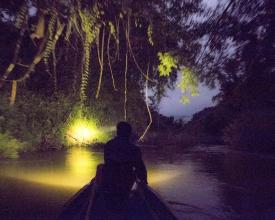
Création d'incitations directes à la protection de la faune et de la flore par le biais de l'écotourisme

Le safari nocturne de Nam Nern est une excursion dans la zone naturelle protégée de Nam Et-Phou Louey, en République démocratique populaire lao, conçue pour inciter les communautés à réduire la chasse et la vente illégales d'espèces menacées d'extinction. Le tourisme a été mis en place comme mesure de réduction des menaces, en plus des activités d'application de la loi et de sensibilisation. Les incitations sont créées par le biais d'un contrat signé avec les 1 186 familles de 14 communautés riveraines de la forêt, qui garantit un revenu aux familles pour chaque touriste et chaque observation d'animaux sauvages au cours de la visite.
Contexte
Défis à relever
Emplacement
Traiter
Résumé du processus
Blocs de construction
Créer un modèle de théorie du changement avec votre équipe
Facteurs favorables
Leçon apprise
Création de contrats de conservation simples avec les communautés
Facteurs favorables
Leçon apprise
Développer et promouvoir le produit touristique
Facteurs favorables
Leçon apprise
Réviser les contrats en tenant compte de l'avis de la communauté (gestion adaptative)
Facteurs favorables
Leçon apprise
Impacts
Trois mesures sont utilisées pour déterminer l'impact du projet. La première est le nombre moyen d'observations d'animaux sauvages par les touristes et le revenu gagné par les communautés. Si les revenus des communautés augmentent, les observations d'animaux sauvages par les touristes devraient également augmenter. Au cours des quatre premières années, les revenus et les observations d'animaux sauvages ont augmenté dans l'ensemble. Toutefois, l'augmentation du nombre d'observations d'animaux sauvages n'indique pas à elle seule un impact positif, car l'augmentation du nombre de touristes le long de la rivière pourrait seulement servir à effrayer les chasseurs et les inciter à se rendre dans d'autres zones, sans qu'il y ait de réduction réelle des menaces. Les menaces font donc également l'objet d'un suivi. Les contrats d'écotourisme créent des incitations négatives à enfreindre les réglementations des zones protégées en réduisant les avantages collectifs et individuels. En conséquence, le projet a pu réduire les infractions de chasse de six à zéro au cours des quatre premières années. Le projet a également comparé le nombre total de signes de chasse (menaces) entre les secteurs de patrouille afin de déterminer l'avantage comparatif d'un secteur avec tourisme par rapport aux secteurs sans tourisme. Le projet a pu démontrer une stabilisation des menaces dans le secteur touristique, contrairement à l'augmentation moyenne des menaces constatée dans les secteurs non touristiques






